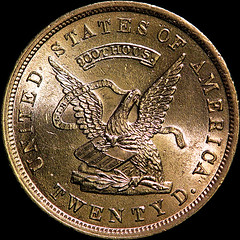
PREV ARTICLE
NEXT ARTICLE
FULL ISSUE
PREV FULL ISSUE
V11 2008 INDEX
E-SYLUM ARCHIVE
ERIC NEWMAN: ADDITIONAL INFORMATION ON THE FRANKLIN HOARD $20 USAOG COINS
My apologies to Eric Newman for the late publication of
this submission regarding the Pioneer Gold Forum and the suspect U.S.
Assay Office of Gold pieces. As noted in this week's Wayne's Words, a
number of people are having trouble with the whomren@coinlibrary.com
address. Eric's note bounced and I didn't get it in time for last week's
issue. -Editor
 As to conclusions reached on August 2, 2008 in
Baltimore on the topic of the 1853 $20 United States Assay Office of Gold
"proof" coinage sponsored by the Society of Private and Pioneer
Numismatists at the ANA Convention a summary by Don Kagin (organizer) and
comments by George Fuld have been published. I feel I might add some
additional information.
As to conclusions reached on August 2, 2008 in
Baltimore on the topic of the 1853 $20 United States Assay Office of Gold
"proof" coinage sponsored by the Society of Private and Pioneer
Numismatists at the ANA Convention a summary by Don Kagin (organizer) and
comments by George Fuld have been published. I feel I might add some
additional information. Based upon a complaint involving a member of the Professional Numismatic Guild, the PNG in 1966 had arbitration rules under which each party would choose one arbitrator and the two selected arbitrators were to choose the third arbitrator. The three arbitrators were obliged to make a unanimous decision. Paul Garland of Tennessee as a claimant asserted that a "proof" 1853 $20 USAOG coin sold to him in 1965 for $3,000 by Tom Ryan of Illinois was a fake and an arbitration was arranged by PNG in 1966. The first hearing was commenced in Chicago with both sides represented. When Paul Franklin was a witness he was asked the details of the source of the "Franklin Hoard" $20 USAOG pieces including the coin under review. Franklin refused to answer and his representatives asserted that no dealer should be required to disclose his business sources. The arbitrators (none of whom were attorneys) sustained that position. That hearing was recorded but the recordation was either lost or disappeared.
There were further investigations, filings, correspondence and interviews by and with the arbitrators in which each side was able to present material separately but no further hearings were set in which both sides were notified to be present so as to have cross examination or document examination privileges.
During the arbitration proceedings it was pointed out that the coin under review and all other known pieces from the "Franklin Hoard" $20 USAOG pieces had 170 reeds on the edge rather than 164 reeds on previously known 1853 $20 USAOG pieces: and also that on at least one of the "Franklin Hoard" pieces there appeared on the face a thin weak incused compact helical or spiral line which seemed to be on the planchet prior to striking. The helical line was asserted to be have been applied by an automatic crosscut lathe.
There was a difference of opinion in the evidence as to whether such a lathe was available in the 1850s when the alleged planchets were prepared. There was no dispute as to the existence of the helix. It was not asserted that the helix was on the die. The identical dents or bag marks on all of the "Franklin Hoard" $20 USAOG coins were not observed during the arbitration although photography was not then as superb as the imaging is now.
Two of the arbitrators informally agreed that the piece under review was a forgery but the third would not agree. All three arbitrators finally agreed in 1967 that the coin was not a "proof" as stated on the invoice and a decision rendered in favor of Garland against Ryan for $3,000. Ryan refused to pay and in due course suit was filed by Garland in a Cook County, Illinois court to enforce the arbitration decision and judgment obtained. Ryan then paid Garland.
Many years passed before the forgery issue arose again. Some of those asserting forgery included Fuld, Bressett, J. P. Martin, Buttrey, Kleeberg, and Dannreuther. Others continued to urge genuineness. There were several vigorous debates and extensive publications. When the identical dents were noticed about 1994 on all known "Franklin Hoard" $20 USAOG pieces the diagnosis of forgery seemed reconfirmed. Then at the 2008 Baltimore session the prototype piece for the forgeries (containing the same dents and with 164 reeds on the edge) was presented, having been located by a member of Don Kagin's firm. A span of over 40 years was needed to produce general acceptance of forgery of "Franklin Hoard" $20 USAOG pieces.
The proper use of the word "forgeries" in the current findings has been chosen in place of "counterfeits" as had been previously urged because numismatic counterfeits are always fraudulently motivated by a producer in an attempt to substitute them for genuine money in actual circulation rather than a desire to make fakes, copies or reproductions after circulation of genuine pieces had ceased, whether or not to cheat or deceive the collector, student, or researcher.
The creation of the "Franklin Hoard" $20 USAOG pieces really passed a hot potato to the numismatic fraternity.
Wayne Homren, Editor
The Numismatic Bibliomania Society is a non-profit organization promoting numismatic literature. See our web site at coinbooks.org.
To submit items for publication in The E-Sylum, write to the Editor at this address: whomren@gmail.com
To subscribe go to: https://my.binhost.com/lists/listinfo/esylum
All Rights Reserved.
NBS Home Page
Contact the NBS webmaster
